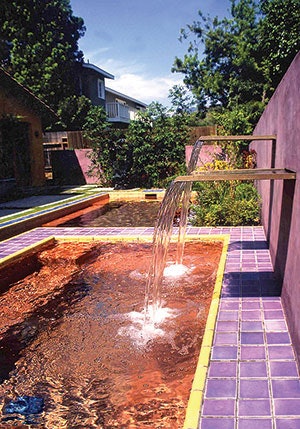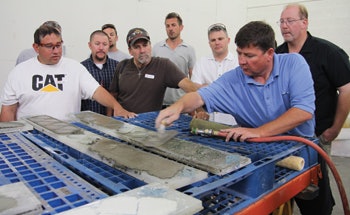 Courtesy of Mark Holden and David Tisherman - Click to enlarge
Courtesy of Mark Holden and David Tisherman - Click to enlarge
Although swimming pools have come a long way since the days when white plaster was the only surface option, many designers still believe there remains far to go before aquatic design exists on par with other architectural arts in terms of color usage. Here Senior Editor Eric Herman takes a look at the state of the color arts in water and a new program designed to expand creative possibilities.
When Henry Ford introduced the Model T, he said you could have it in any color you wanted, so long as it was black. As we know, despite that chromatic limitation, Ford would essentially invent the U.S. auto industry and for a long time, consumers accepted they had no choice when it came to color. That would eventually change in a big way, to the point where automobile finishes are an often-dazzling art form.
There’s a somewhat parallel story to be told with swimming pools, where the only color option available for the majority of the 20th Century was white, specifically white plaster or “Marcite,” as some call it. To this day, the basic combination of white Portland cement, aggregate and water remains an enduring mainstay. In fact, the vast majority of commercial pools are required by health codes to be white, presumably for safety reasons.
Fortunately, things have evolved on the residential front in terms of color choices. The advent of the so-called “black-bottom pool” began to emerge in the 1960s and ever since, consumers have been able to obtain pools other than white, mostly in shades of gray. In the 1970s the introduction of exposed-aggregate or pebble surfaces opened things up even further with color variations by mixing mostly white, gold and black pebbles, with later additions of jade gray, lapis and others.
Pre-mix suppliers have stepped up as well and expanded the offerings even further with polished aggregates, colored sand and cement colored using varying combination of organic and inorganic pigments.
Perhaps the biggest journey around the color wheel has come courtesy of tile manufacturers, who provide a seemingly infinite universe of colors — the sole limitation being the often-extravagant cost of an all-tile pool finish.
As a result, for decades now, designers, builders and their clients have had an increasing range of color choices, all part of a developmental arc through which pools and other types of water features have become an emergent art form, at least when designed and built by those who understand design and how to use color.
FARTHER ON
Despite all of that advancement, many designers argue that when it comes to cementitious finishes of pools and spas, the choices are still relatively limited when compared to other areas where cement and color come together. Stucco used on building exteriors and interiors, for example, can be readily produced across the color spectrum in endless colors. The same can be said of decorative concrete used in architectural and decorative applications.
Pool and spa finishes, by comparison, remain limited to just a few dozen, or fewer depending on how you count. “Traditionally, the pool and spa industry views color as a commodity,” says landscape architect and aquatic designer Mark Holden. “You’ve had a certain set of choices and very little beyond that, especially when it comes to colored plaster. Sure, suppliers such as Pebble Technology and some pre-mix suppliers have done a great job expanding choices, but when it comes to colored plaster or concrete, our industry has been extremely limited.
“I believe we should be able to choose plaster colors the way consumers pick and choose among paint colors for their homes exteriors and interiors, or the way you choose a new color for your car. That level of freedom would be a quantum step forward in our ability to expand homeowners’ choices and experience an entirely different level of creativity in aquatic design.”


Working with colored plaster requires understanding the physical nature of cement and aggregate, admixtures, pigment and proper application techniques, all disciplines that can be surprisingly tricky to master.
TAKING ACTION
All of that is why this past May, Holden and designer/builder David Tisherman debuted their new educational vehicle, ART (Artistic Training & Resources), with a program devoted to colored plaster, presented appropriately at the Pebble Technology headquarters in Scottsdale, Ariz. “Our goal,” explained Holden, “is to change the way our industry works with color so that designers and consumers have a broader set of choices.”
As both Holden and Tisherman readily admit, working with colored plaster and other cementitious products is nothing new. For centuries, frescos, including the ceiling of the Sistine Chapel have been rendered using a mix of pigments and plaster. In a more contemporary context, the decorative concrete industry has used to color to tremendous ends to the point where almost any object can be replicated in concrete.
“Unfortunately,” says Tisherman, “the pool and spa industry has treated color as though you’re walking down an aisle at a grocery store. We select products off the shelf. Very few in this industry understand how to work with the basic ingredients to create our own recipes.”
The presentation in Scottsdale was kicked off by plasterer Shawn Still, who covered the basics of plaster mixes and the differences in products offered by various manufacturers. As Still pointed out, working with the basic components of cement, aggregate and colorants, almost any color can be produced in plaster, but the fear of the unknown and how those colors will perform in water has caused many in the industry to play it safe.
He pointed out that the solubility of calcium carbonate, the primary chemical constituent in plaster, has traditionally rendered the material susceptible to chemical attack, a fact that is measured using the Mohs scale of mineral hardness. Plaster rates a 3, while pebble surfaces typically rate a 7, which is one of the reasons why pebble surfaces have become so popular.
That said, the color of pebble surfaces is determined almost entirely by the mix of pebbles provided by manufacturers, which inevitably gives designers a predetermined set of color options. The advent of other aggregate types such as quartzite, glass beads and even seashells have added greater aesthetic options and durability. The use of admixtures such as pozzolans and metakalins, which transform the most-soluble compounds in plaster such as calcium hydroxide to sturdier constituents, have added greater durability.
Despite these advancements, the challenge of capturing the entire color spectrum in a durable plaster surface remains an elusive one.
THE COLOR MIX
With Still’s explanation of the plaster and its many variants as a foundation, the program shifted to a discussion presented by Shawn Hayes of Delta Performance Products, a manufacturer of color pigments.
Highlights of his presentation included:
• The use of pigment to create color dates back thousands of years to prehistoric cave paintings in Africa, meaning essentially that it’s the oldest known means of human creative expression.
• A common definition of color is “the perceptual characteristic of light described by a color name.” It’s a physical phenomenon of the electromagnetic spectrum from about 400 to 800 nanometers. It is absorbed, reflected and transmitted. Color requires a light source, which has tremendous impact on the way we perceive color. Surface texture also greatly influences the appearance of color.
• Pigments absorb certain wavelengths of light and reflect others. Different materials absorb different frequencies, meaning that by manipulating pigment chemistry we are able to create different colors.
• There are no dyes used in concrete, only pigments. Pigments are discreet particles in the concrete mix: dyes are soluble, while pigments are not.
• Pigments are either organic or inorganic. Organic compounds contain carbon; inorganic compounds do not. The most common pigment used in the world is carbon black (organic), the second most common is titanium dioxide white (inorganic). Most organic pigments are created by nature and can be mined and refined so they can be used in making color.
• Inorganic pigments, which constitute the majority of those used in cementitious applications, are combinations of metals that are roasted at extremely high temperatures causing them to fuse together to make different colors. Common examples are cobalt blue, widely used in a number of applications, chromium oxide green, most commonly identified with the color of tennis courts, iron oxides, basically sophisticated rusts delivering a spectrum of red colors, and chrome yellow, most notably used in traffic paint. These inorganic pigments are extremely stable and constitute the majority of compounds used to create colored concrete.
• Different pigments have varying characteristics in terms of performance in different settings and uses. Some are more resistant to acid, for example, and are better suited to use in plaster that is submerged in pool water.
• The choice of cement used in the mix will greatly influence the finish color. Pigments mixed with white cement tend to create pastels, while those mixed with gray cement will produce tints.
• Mixing pigments to create different colored concrete is an extremely sophisticated and precise process, with exacting ratios and weight of materials based on the characteristics of the pigments and the desired color. As a general rule, pigments constitute 3 to 5 percent of the total mix.
The Design Side
Understanding how to manipulate color in concrete is an important step in opening up possibilities for builders and their clients. Making effective use of those colors is another issue entirely, according to David Tisherman. “You have to understand design and color theory,” he says. “Otherwise, simply having different colors available to you means very little or nothing.”
In developing the ART program, mentioned in the adjoining text, Tisherman and partner Mark Holden, have devised a program called Pebble Art, through which they will make measured color pigment batches available to students who have met prerequisite courses in color, including color theory classes taught by colorist Judith Corona of UCLA, the first instructor to introduce color education to the industry, or courses taught at accredited universities.
Says Holden, “Our goal is to make a greater set of tools available to designers and builders, but first make sure our students have the education they need to make use of those tools.” —E.H.












































